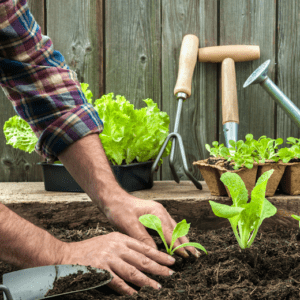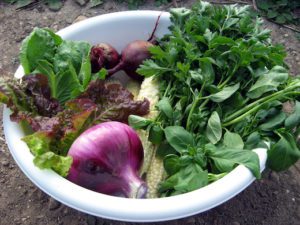What Should I Plant with My Lettuce?
Many of us know lettuce as the versatile leafy green used as a base for salads, a topping for sandwiches, and an occasional edible garnish. It’s mild crunch makes it the perfect companion for many dishes, and often adds a textural zing which enhances equal and opposite flavors and textures. Lettuce is grown on a worldwide scale on farms and in gardens of all sizes. The history of this leafy green can be traced all the ways back to Ancient Egypt, and was even described as a medicinal herb in some ancient texts. Changes in growing, packing, and storing procedures have allowed us to enjoy the fresh crisp of lettuce for longer periods of time, and have allowed it to be shipped over longer distances.

Although it is an easy plant to grow, lettuce is susceptible to various diseases, pests, and fungi, which can quickly destroy your crop. There are several known methods to control these natural occurrences. Many of these are common solutions such as pesticides, crop rotation, and our topic of the day: companion plants. A farm or garden that uses companion planting simply plants different crops together that will mutually benefit each other. These benefits are seen through things like shade, attraction of beneficial insects, pollination, and pest mitigation. Lettuce has a number of crops that it helps, and enjoys a symbiotic relationship with other fruits and veggies as well.
The Best Companion Plants for Lettuce
Before we just plant any old thing alongside our lettuce crop, it’s imperative to note that some companions are antagonistic to others on the list. For instance, both beets and beans are helpful plants for lettuce, but growing both in proximity to each other should be avoided at all costs. With this in mind, let’s come up with a few scenarios in which all crops are in perfect harmony.
Lettuce and Broccoli, the Odd Couple
Broccoli is classified as a brassica. Brassica is the cabbage family, which includes brussel sprouts, cauliflower, turnips, rutabaga, and of course, cabbage. It is common practice to avoid planting these with lettuce, but broccoli seems to be an anomaly when it comes to this theory. According to a study in The Journal of Animal and Plant Sciences, broccoli and lettuce are much more bountiful crops when planted together than when planted by themselves. Although the intercropping of these two plants only slightly improved broccoli production, it did greatly enhance lettuce growth. It is advisable, however, to avoid other members of the brassica family when companion planting with lettuce.
Lettuce with a Supporting Cast of Garlic, Beets, and Strawberries
Your lettuce is basking in the company of good friends. Garlic has the ability to repel insects, particularly aphids, which are harmful to lettuce crops. Beets enrich the soil when their old leaves compost onto it and add a shot of magnesium. Strawberries and lettuce tend to grow well together because of how their root systems are structured. While these plants may not have a direct benefit to each other, they will grow in support of each other nicely, and will promote a more bountiful and diverse yield when it comes to harvest time.
Lettuce Gives Back to Radishes
Like our other contestants, lettuce and radish is a match made in heaven. When grown in summertime, the lettuce actually causes an improvement in the quality of radishes. The pairing of these two together in the same garden allows for the radishes to have a more tender texture when they’ve reached full maturation. There’s no direct quality benefit to the lettuce here, but these two vegetables do tend to grow well together.
summertime, the lettuce actually causes an improvement in the quality of radishes. The pairing of these two together in the same garden allows for the radishes to have a more tender texture when they’ve reached full maturation. There’s no direct quality benefit to the lettuce here, but these two vegetables do tend to grow well together.
Radishes, Cucumbers, and Lettuce Oh My!
The previous scenario extolled the virtues of radishes and lettuce harmonizing eloquently with the touch of a classical composer. Adding cucumber to the mix serves to solidify their melody like a tastefully crafted bass line. This simile holds true as planting too much cucumber can overcrowd the other crops due to the large amount of space that it occupies when growing. In this scenario, radishes provide protection against the cucumber beetle, allowing the cucumber plants to safely reach maturation without the risk of pest infestation. With lettuce gifting the radishes with a more desirable flavor profile, and the radishes in turn protecting the cucumber from a potentially devastating insect, this is one of the strongest combinations of companions available.
Lettuce and Onions: Not Just a Sandwich Topping
Since these two do often create a delightful flavor and texture juxtaposition on your favorite sandwich, it almost feels natural that they’d make great growing companions, and they do! There are two methods, which work wonderfully, and create a mutually beneficial relationship between these close companions. The first method is to use the hole created by pulling the onions out during harvesting to plant your leaf lettuce. The hole left by the onion actually provides a good home to the shallow root system of the lettuce. The compost left behind is an excellent fertilizer, and the smell will drive away rabbits if you find them to be an issue in your garden. The other method is to simply plant both of them together. Onions do draw pests, so it is important to plant them in a more scattered fashion.
Each of these scenarios proves why companion planting is a functional method for protecting lettuce, increasing yield, and promoting a more diverse crop harvest. Lettuce is an important staple on a global level, which carries the added benefit of a wide range of versatility. Each companion plant, and each possible combination of beneficial companion planting serves to increase not only the previously mentioned qualities of lettuce, but of your garden in general. Remember, however, that not all companions work among themselves, so make sure to research which ones are the most beneficial for your gardening goals!